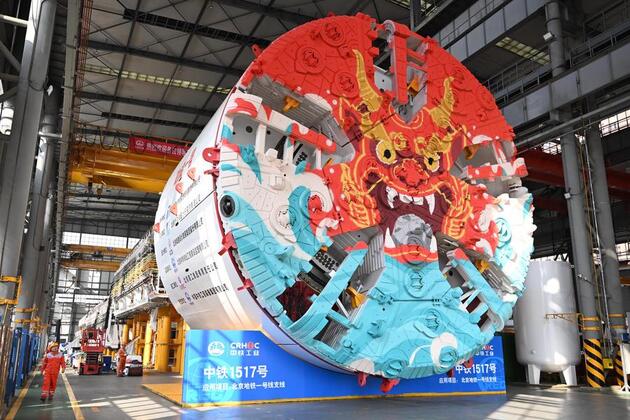2LT National News
Tunneling machine highlights rise of Chinese manufacturing
Nov 9, 2025
ZHENGZHOU, Nov. 9 (Xinhua) — In Zhengzhou, central China’s Henan Province, an advanced tunnel boring machine (TBM) rolled off a production line this week, ready to be deployed for the construction of an underwater branch of Beijing Subway Line 1.
The device, with an innovative stone handling system, can realize continuous tunneling, precise screening and mechanical transport of boulders — offering a breakthrough solution for shield construction in challenging cobble strata.
Independently designed and produced by China Railway Engineering Equipment Group Co., Ltd. (CREG), the country’s largest TBM manufacturer, this TBM underscores the rapid development of China’s advanced manufacturing sector.
As early as 1825, beneath the River Thames, French engineer Marc Isambard Brunel had constructed the world’s first tunnel to use a shield tunneling method. This pioneering technology was subsequently refined and widely adopted across Europe.
However, more than a hundred years later, when the first phase of the Beijing Subway Project (later renamed Line 1) started construction in 1965, China’s tunnel boring industry was still in its primitive stage.
With a weak industrial base and no core technologies, construction relied heavily on manual excavation — an inefficient and high-risk approach. “We had only read about the subway in books — none of us had ever seen it,” said Wang Xinjie, the then designer at the underground railway survey and design office in Beijing.
In recent years, fueled by scientific and technological innovation, Chinese tunneling technology and equipment have progressed rapidly, transforming the country from a follower to a frontrunner in the global TBM industry.
Notably, the production and sales volume of CREG have ranked first in the world for the past eight consecutive years. Its shield machines have excavated over 5,000 kilometers of tunnels in total — supporting infrastructure construction in metro, railway, highway, mining, water conservancy and municipal work, among others.
“China’s vast territory and diverse geology have served as a natural testing ground, allowing TBM manufacturers to accumulate experience, develop technologies and enhance equipment adaptability,” said Wang Weibo, an official with CREG.
The remarkable transformation of China’s TBM industry underlines the country’s strong determination to boost manufacturing.
According to a pivotal document outlining priorities for the country’s next five-year plan, China should consolidate and enhance the position and competitiveness of its industries such as mining, machinery and construction in terms of the global industrial division of labor.
It should also ensure its industrial chains become more self-supporting and risk-resilient, advance industrial foundation reengineering and research on major technologies and equipment, and develop advanced manufacturing clusters.
So far, China has produced over 4,000 TBMs — accounting for about 70 percent of the global market share. With high quality and customized services, Chinese-made machines are attracting an increasing number of foreign clients.
CREG has exported its shield products to more than 30 countries and regions in the world, including Denmark, France, Italy, Canada, Brazil, Singapore, Malaysia, Thailand and the United Arab Emirates.
Whether in the freezing areas of Northern Europe or the scorching deserts of the Middle East, the Chinese company can always provide timely and professional technical support and after-sales services.
At a CREG factory in Zhengzhou, Hacia, a TBM decorated with green aboriginal paintings, was undergoing its final tests. Named by second-grade students from Glen Waverly Primary School, it will mark the fifth shield machine CREG has supplied to Australia.
The device will soon be sent from Zhengzhou to Melbourne for a suburban rail loop project. When finished, the project will effectively alleviate traffic congestion and shorten public transport time.
Chris Kolodynski, an electrical superintendent from Australia, was checking the main functions of Hacia with his colleagues. “People are looking forward to the new metro line. It will be beneficial,” he said.
To promote its core technologies, Chinese giant CREG has adhered to the principle that science and technology are the primary productive force, with its research and development (R) spending sustained at roughly 9 percent for years.
In 2024, China’s total R spending had surpassed 3.6 trillion yuan (around 508.22 billion U.S. dollars), according to Yin Hejun, Chinese minister of science and technology.
From 2026 to 2030, China will develop a modern industrial system with advanced manufacturing as the backbone, said the above-mentioned pivotal document.
Meanwhile, the country will strive to enhance the overall performance of its innovation system, achieve a leading position in scientific and technological development, and keep fostering new quality productive forces, it added.



